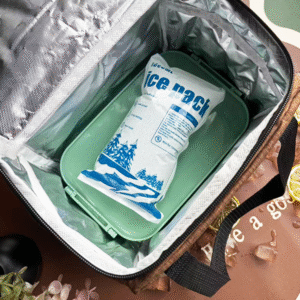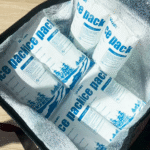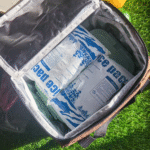Wiederverwendbare Trockeneisbeutel für Insulin – wann sind sie sicher und welche Optionen sind besser??
Einführung: Reisen oder Transport mit Insulin erfordern eine sorgfältige Temperaturkontrolle. Sie fragen sich vielleicht, ob wiederverwendbare Trockeneisbeutel für Insulin sind eine praktische Lösung. Dieser Leitfaden erklärt, warum Trockeneis normalerweise nicht für Insulin empfohlen wird, wie man extreme Kälte mit Phasenwechselmaterialien abfedert (PCMs), und wann wiederverwendbare Trockeneisbeutel angebracht sein könnten. Sie lernen sicherere Alternativen wie Gel-Packs und PCM-Steine kennen, die eine Temperatur von 2–8 °C aufrechterhalten, und erhalten Schritt-für-Schritt-Anleitungen zum Schutz Ihrer Medikamente auf langen Reisen oder in Notfällen.

Sind wiederverwendbare Trockeneisbeutel sicher für Insulin?? – Verstehen Sie, warum Trockeneis Insulin schädigen kann und wie Sie es mit PCM puffern können.
Wann sollten Sie einen Trockeneisbeutel für Insulinreisen in Betracht ziehen?? – Informieren Sie sich über die Szenarien, in denen Trockeneis erforderlich sein könnte, und über die Größenregeln für Reisen.
Wie baut man eine sichere Packung für Insulin auf?? – Befolgen Sie eine praktische Schichtmethode, um das Insulin dazwischen zu halten 2 Und 8 °C.
Was sind bessere Alternativen zu Trockeneisbeuteln?? – Entdecken Sie Gelpacks und PCMs, die längere Haltezeiten ohne Einfrieren bieten.
Wie sollten Sie gelbasierte Trockeneisbeutel lagern und wiederverwenden?? – Erfahren Sie Tipps zur Wartung und Wiederverwendung, um Abfall zu reduzieren und Ihre Vorräte zu schützen.
Was sind die 2025 Trends beim Insulintransport in der Kühlkette? – Entdecken Sie Innovationen bei Sensoren, umweltfreundliche Materialien, und Fluglinienvorschriften.
Sind wiederverwendbare Trockeneisbeutel sicher für Insulin??
Direkte Antwort: Allgemein, NEIN. Insulin ist ein empfindliches biologisches Produkt, das zwischendurch gekühlt aufbewahrt werden muss 2 Und 8 °C. Herkömmliches Trockeneis hat eine Temperatur von −78 °C und kann Insulin gefrieren und denaturieren, wenn es direkt darauf platziert wird, es unsicher machen. Sogar wiederverwendbare „Trockeneis-Packs“, die für den Versand vermarktet werden, beziehen sich oft auf Gel-Packs oder PCMs, die Trockeneistemperaturen nachahmen, aber wiederverwendbar bleiben. Den Unterschied zwischen echtem Trockeneis verstehen (Solid Co₂) und leistungsstarke Gelpacks sind unerlässlich.
Erweiterte Erklärung: Trockeneis sublimiert bei −78 °C direkt zu Kohlendioxidgas. Aufgrund seiner starken Kälte eignet es sich ideal für den Versand von Tiefkühlkost oder Biologika, die unter –20 °C bleiben müssen, aber Insulin verliert seine Wirksamkeit, wenn es eingefroren wird. Aufsichtsbehörden und Diabetesverbände warnen ausdrücklich vor der Verwendung von Trockeneis für Insulin, da bereits ein kurzer Kontakt dazu führen kann, dass das Medikament gefriert, was zu Verklumpungen oder Kristallbildung führt. „Trockeneisbeutel“ auf Gelbasis,Andererseits, Verwenden Sie unterkühlte Gele oder PCMs, um Temperaturen unter dem Gefrierpunkt ohne die Gefahr der CO₂-Sublimation zu erzielen; Jedoch, Sie sind immer noch nicht ideal für Insulin, wenn sie nicht mit gepuffert sind +5 °C PCM-Steine.
Trockeneis vs. Gel-Packs vs. PCMs: Temperaturbereiche und Eignung
| Kältemitteltyp | Ungefährer Temperaturbereich | Typische Haltezeit | Eignung für Insulin | Wichtige Vorteile & Nachteile |
| Trockeneis (Solid Co₂) | –78 ° C.; extrem kalt | 24–72 Stunden, sublimiert allmählich | Nicht empfohlen; Friert Insulin ohne Puffer ein | Höchste Kühlleistung; Ideal für gefrorene Waren; erfordert Entlüftung und Compliance. |
| „Trockeneis“-Packungen auf Gelbasis | –20 °C bis 0 °C | 12–36 Stunden je nach Größe | Nicht empfohlen, wenn es direkt neben Insulin platziert wird; müssen gepuffert werden | Wiederverwendbar und wieder einfrierbar; keine Sublimation; immer noch zu kalt für Insulin ohne Zwischenschicht. |
| Phasenwechselmaterial (PCM) Packungen (Z.B., +5 °C-Steine) | +2 ° C bis +8 °C | 24–52 Stunden für isolierte Rucksäcke | Ideal für Insulin; bleibt im geforderten Bereich | Bietet eine präzise Temperaturregelung; wiederverwendbar; eliminiert die Gefahr des Einfrierens. |
| Hydrogel-Verdunstungspackungen | Um +20 °C; nutzt die Wasserverdunstung | 40–50 Stunden | Nützlich für ungekühltes Insulin; Nicht für Sendungen, die eine Temperatur von 2–8 °C benötigen | Aktiviert durch Wasser; erfordern ein Einweichen; gut für Outdoor-Reisen; sicher im Handgepäck zu verwenden. |
Praktische Tipps und Anregungen
Vermeiden Sie direkten Kontakt mit Trockeneis: Platzieren Sie immer a +5 °C PCM-Puffer zwischen Insulin und Trockeneis oder einer Gelpackung unter Null, um ein Einfrieren zu verhindern.
Wählen Sie für typische Reisen Gel oder PCM: Für Fahrten unter 24–36 Stunden, Konditionierte Gelpackungen oder PCM-Steine sind einfacher zu handhaben und ersparen den Papierkram mit Trockeneis.
Etiketten verstehen: Bei vielen „Trockeneisbeuteln“ auf E-Commerce-Websites handelt es sich tatsächlich um hochdichte Gelbeutel; Lesen Sie die Beschreibungen sorgfältig durch und achten Sie auf den sicheren Temperaturbereich.
Tatsächlicher Fall: Während einer 52-stündigen Tür-zu-Tür-Route, Ein Reisender hatte drei Insulinpens dazwischen 3.2 °C und 7.6 °C durch Verwendung eines starren Innengehäuses, zwei +5 °C PCM-Steine und 0.6 kg Trockeneis in einem belüfteten Außenbehälter. Der geschichtete Ansatz verhinderte ein Einfrieren und sorgte während der gesamten Fahrt für Stabilität.
Wann sollten Sie einen Trockeneisbeutel für Insulinreisen in Betracht ziehen??
Direkte Antwort: Verwenden Sie einen wiederverwendbaren Trockeneisbeutel für Insulin nur, wenn Sie mehrere Tage in heißen Klimazonen reisen (≥ 32 °C) oder wenn Sie länger als 36–72 Stunden keinen Zugang zur Kühlung haben. In diesen Extremsituationen, Um die Kühlung zu verlängern, kann Trockeneis erforderlich sein, Sie müssen jedoch einen Wärmepuffer hinzufügen, z +5 °C PCM-Steine – zwischen Insulin und Trockeneis. Für kürzere Touren oder gemäßigte Temperaturen, Nur PCM-Packouts sind leichter, einfacher und sicherer.
Erweiterte Erklärung: Stellen Sie sich Ihren Isolierbehälter als ein thermisches „Sandwich“ vor. Das Insulin sitzt in einem starren Innengehäuse, umgeben von +5 °C PCM-Steine, die den sicheren Temperaturbereich einhalten. Anschließend wird diese Baugruppe mit expandiertem Polystyrol isoliert (EPS), expandiertes Polypropylen (EVP) oder vakuumisolierte Paneele (VIPs). Trockeneis sitzt außerhalb der PCM-Schicht im äußeren Hohlraum, mit Entlüftungsöffnungen zur Freisetzung von CO₂. Diese Anordnung drosselt die extreme Kälte, Dadurch kann das PCM Energie absorbieren und ein direkter Kontakt mit dem ultrakalten Trockeneis wird verhindert. Das Ergebnis ist eine stabile Umgebung mit 2–8 °C, auch über einen längeren Zeitraum, heiße Routen.
Größenregeln und Entscheidungshilfe
| Umgebungstemperatur & Dauer | Empfohlene Auspackstrategie | Trockeneismenge | PCM-Puffer |
| Leicht (≤25 °C), ≤18 Std | Nur PCM; kein Trockeneis notwendig | 0 kg | Zwei +5 °C PCM-Steine halten 2–8 °C aufrecht. |
| Warm (25–32 °C), 18–36 h | Zusätzliche Isolierung und PCM; Vermeiden Sie nach Möglichkeit Trockeneis | 0–0,5 kg/Tag | Drei oder mehr +5 °C PCM-Steine oder konditionierte Gelpackungen. |
| Heiß (≥32 °C) oder mehrtägig (≥36 Std) | Gepufferter Trockeneisbeutel raus | 0.5–0,8 kg/Tag | Vier oder mehr +5 °C PCM-Steine zur Abschirmung von Insulin. |
Praktische Tipps und Anregungen
Stellen Sie sich fünf Fragen: Wie viele Stunden dauert Ihre Reise?? Wie hoch ist die maximale Umgebungstemperatur?? Wie viele Stifte oder Fläschchen tragen Sie?? Werden Sie von der Kühlung getrennt?? Erlauben die Vorschriften der Fluggesellschaft Trockeneis auf Ihrer Route?? Durch die Beantwortung dieser Fragen können Sie feststellen, ob Sie Trockeneis benötigen.
Führen Sie einen Probelauf durch: Führen Sie vor Ihrer eigentlichen Reise einen 12–24-Stunden-Test mit einem Temperaturlogger durch, um sicherzustellen, dass Ihr Rucksack eine Temperatur von 2–8 °C aufrechterhält.
Vorwiegen und beschriften: Beim Fliegen, Fluggesellschaften erlauben normalerweise bis zu 2.5 kg (5.5 lb) Trockeneis pro Passagier. Beschriften Sie das Nettogewicht und belüften Sie den Behälter, um den IATA-Vorschriften zu entsprechen.
Tatsächlicher Fall: Ein Reisender auf einer 36-stündigen Reise bei heißem Wetter benutzte einen isolierten Behälter mit vier Stück +5 °C PCM-Steine und 0.7 kg Trockeneis. Der Datenlogger zeigte Temperaturen dazwischen 2.8 °C und 7 °C während der gesamten Fahrt, Dies beweist, dass richtig gepuffertes Trockeneis Insulin unter extremen Bedingungen schützen kann.
Wie stellt man eine sichere Packung für Insulin zusammen??
Direkte Antwort: Der sicherste Weg, Insulin mit wiederverwendbaren Trockeneisbeuteln zu transportieren, ist der Aufbau einer mehrschichtigen Packung: Kühlen Sie Ihre PCM-Steine vor, Platzieren Sie Insulin in einem starren Behälter, umgeben Sie es mit +5 °C PCM-Steine auf allen Seiten, Isolierung hinzufügen, Platzieren Sie dann das Trockeneis außerhalb der PCM-Schicht und stellen Sie sicher, dass der äußere Behälter über Lüftungsschlitze verfügt. Diese Anordnung verhindert ein Einfrieren und entspricht den Vorschriften.
Schritt-für-Schritt-Anleitung:
PCM vorkonditioniert: Platzieren Sie Ihre +5 °C PCM-Bricks oder Gel-Packs im Kühlschrank aufbewahren (kein Gefrierschrank) für zumindest 24 Stunden, um sie bei 2–8 °C zu stabilisieren.
Bereiten Sie das Insulin vor: Bewahren Sie Insulinpens oder -fläschchen in einem stabilen Kunststoff- oder Metallgehäuse auf, um ein Zerdrücken zu verhindern. Setzen Sie Insulin nicht direkt Trockeneis oder Gelpackungen mit Temperaturen unter Null aus.
Schicht mit PCM: Umwickeln Sie den Insulinbehälter an vier bis sechs Seiten mit PCM-Steinen, Stellen Sie sicher, dass zwischen Insulin und jedem Sub-Null-Element ein Puffer von mindestens 1–2 cm vorhanden ist.
Isolierung hinzufügen: Verwenden Sie hochwertige Isolierung wie EPS, EPP- oder VIP-Platten zur Verlangsamung der Wärmeübertragung und Reduzierung der benötigten Trockeneismenge.
Trockeneis legen: Legen Sie Trockeneisblöcke oder -pellets in den äußeren Hohlraum, außerhalb der PCM-Schicht. Lassen Sie Platz für das Entweichen von CO₂-Gas und verschließen Sie den Behälter niemals luftdicht.
Beschriften und lüften: Markieren Sie den Behälter mit „DRY ICE / KOHLENDIOXID, SOLID“ und das Nettogewicht. Stellen Sie sicher, dass Entlüftungsöffnungen oder Löcher im Deckel das Entweichen des Gases ermöglichen.
Überwachen Sie die Temperatur: Setzen Sie einen Datenlogger in das Insulinfach ein, um die Temperaturen zu verfolgen; Stellen Sie Alarme ein 2 °C und 8 °C mit einer 10-minütigen Verzögerung für die Bearbeitung von Ereignissen.
Praktische Tipps und Anregungen
Kühlen Sie den Kühler vor: Vor dem Packen, Kühlen Sie Ihren Isolierbehälter, indem Sie mindestens PCM oder Kühlakkus hineinlegen 1 Stunde.
Fläschchen in Folie oder Stoff einwickeln: Das Einwickeln von Insulin in Aluminiumfolie oder ein Handtuch sorgt für eine weitere Isolierschicht und verhindert direkte Kältebrücken.
Vermeiden Sie Überpacken: Zu viel Trockeneis kann den PCM-Puffer einfrieren; Befolgen Sie die Größenregeln und passen Sie sie je nach Umgebungsbedingungen an.
Tatsächlicher Fall: Eine abgelegene Klinik, die Insulin in eine ländliche Gegend verschickt, schichtete Insulinfläschchen mit +5 °C PCM-Steine in einem mit VIP ausgekleideten Container. Sie platzierten 0.8 kg Trockeneis in das Außenfach und belüftete die Box. Der Logger zeichnete zwischendurch stabile Temperaturen auf 3.5 °C und 6 °C über 48 Std., Einhaltung gesetzlicher Vorschriften und Vermeidung von Frostschäden.
Was sind die besten Alternativen zu Trockeneisbeuteln für Insulin??
Direkte Antwort: Gelpacks und Phasenwechselmaterialien (PCMs) eingestellt auf +5 °C sind sicherere Alternativen zu wiederverwendbaren Trockeneisbeuteln für Insulin. Sie halten den erforderlichen Temperaturbereich von 2–8 °C ein, ohne dass die Gefahr des Einfrierens besteht, erfordern keine besondere Belüftung oder Gefahrenkennzeichnung, und sind für das Handgepäck bei Fluggesellschaften zugelassen. Hydrogel-Kristallpackungen, die auf Verdunstungskühlung basieren, sind eine weitere wiederverwendbare Option für Insulin bei Raumtemperatur, eignen sich jedoch nicht für den Kühlversand.
Erweiterte Erklärung: Gelpacks sind mit ungiftigem Material gefüllte Beutel, Gele in Lebensmittelqualität, die bei etwa 0–4 °C gefrieren und im gefrorenen Zustand flexibel bleiben. Medizinische Gelpackungen enthalten häufig phasenwechselnde Materialien, wie Biogel, die die Temperatur bis zu halten 33 Stunden im Kühlschrank und mehr 52 Stunden bei Raumtemperatur. Sie sind langlebig, dicht, und verursachen bei der Handhabung keine Erfrierungen. PCMs, die so konstruiert sind, dass sie schmelzen +5 °C bieten eine noch strengere Temperaturkontrolle und können tausende Male wiederverwendet werden.
Hydrogel-Verdunstungspackungen, auch „wasseraktivierte Trockeneisbeutel“ genannt,„Verwenden Sie Kristalle, die Wasser absorbieren und langsam verdunsten, um das Insulin länger kühl zu halten 45 Std.. Diese Rucksäcke sind leicht und praktisch zum Wandern oder Campen, können jedoch bei großer Hitze keine Temperatur von 2–8 °C aufrechterhalten. Sie eignen sich am besten für Insulin bei Raumtemperatur, das nicht gekühlt werden muss.
Vorteile von Gel Pack und PCM auf einen Blick
| Lösung | Kühlbereich | Typische Haltezeit | Wiederverwendbarkeit & Nachhaltigkeit | Vorteile für den Benutzer |
| Gelpackung in medizinischer Qualität | 0–4 °C | Bis zu 33 Stunden gekühlt; 52 Stunden bei Raumtemperatur | Wiederverwendbar; ungiftig; dicht | Sicher für die Mitnahme im Flugzeug; verhindert das Einfrieren; flexibel und langlebig. |
| +5 °C PCM-Stein | +2 ° C bis +8 °C | 24–48 Stunden je nach Isolierung | Sehr wiederverwendbar; nachhaltig; reduziert Abfall | Präzise Temperaturregelung; Vorschriftenregulierung; umweltfreundlich. |
| Hydrogel-Verdunstungspackung | ~+20 °C (Kühlung durch Verdunstung) | 45 Stunden oder mehr | Nach Rehydrierung wiederverwendbar; keine Kühlung erforderlich | Ideal für Outdoor-Abenteuer; Leichtes Gewicht; TSA-zugelassen. |
Praktische Tipps und Anregungen
Entscheiden Sie sich für PCMs für lange Reisen: PCMs halten 2–8 °C aufrecht und sind für Insulin unbedenklich. Sie sind einfach zu verwenden – einfach vorher abkühlen lassen 5 °C und laden Sie es in Ihren Isolierkoffer.
Kombinieren Sie Gelpacks mit Isolierung: Für einen kurzen Flug kann ein einzelner Gelpack ausreichen, Das Hinzufügen einer Isolierhülle oder einer reflektierenden Folie kann die Haltezeit jedoch verdoppeln.
Verdunstungspackungen richtig hydrieren: Hydrogel-Kristallpackungen für die empfohlene Dauer in sauberem Wasser einweichen, Tupfen Sie dann überschüssiges Wasser ab, bevor Sie es in Ihr Reiseset geben.
Tatsächlicher Fall: Ein Marathonläufer, der zu einem abgelegenen Rennen reiste, nutzte Hydrogel-Verdunstungspackungen, um das Insulin in einer Gürteltasche kühl zu halten. Das Rudel, mit Wasser aktiviert, sorgte in einem gemäßigten Klima fast zwei Tage lang für Kühlung, Wir zeigen, wie innovative Alternativen einzigartige Reisebedürfnisse erfüllen können.
Wie sollten Sie gelbasierte Trockeneisbeutel aufbewahren und wiederverwenden??
Direkte Antwort: Bewahren Sie wiederverwendbare Trockeneisbeutel auf Gelbasis kühl auf, Trockener Ort, wenn er nicht verwendet wird. Frieren Sie sie erneut flach ein 24 Stunden vor jeder Fahrt und prüfen Sie, ob Undichtigkeiten oder Löcher vorhanden sind. Viele Hochleistungs-Gel-Packs können bei richtiger Pflege Dutzende Male wiederverwendet werden. Um das Leben zu verlängern, Vermeiden Sie es, schwere Gegenstände auf die Kühlakkus zu legen und halten Sie sie von scharfen Gegenständen fern.
Erweiterte Erklärung: Gelpackungen mit der Bezeichnung „Trockeneispackungen“ beziehen sich oft eher auf superkalte Gelpackungen als auf reines Kohlendioxid. Diese Packungen können wiederholt wieder eingefroren werden, da das Gel im Beutel verbleibt. Nach jedem Gebrauch, Lassen Sie die Packung auf Raumtemperatur erwärmen und wischen Sie das Kondenswasser ab. Überprüfen Sie die Nähte auf Abnutzung und ersetzen Sie jeden Rucksack, der aufgequollen aussieht oder undicht ist. Zur Aufbewahrung zwischen Fahrten, Bewahren Sie die Packungen in einem verschlossenen Plastikbeutel im Gefrierschrank auf; Dies verhindert die Bildung von Eiskristallen auf der Oberfläche und reduziert Gefrierbrand. Wenn Sie ungenutztes Trockeneis aus einer Lieferung retten, Fassen Sie es mit isolierten Handschuhen an und bewahren Sie es bis zum Gebrauch in einem gut belüfteten Kühler auf.
Lagerung & Wartungscheckliste
Nach Gebrauch prüfen: Suchen Sie nach Einstichen, Schwellungen oder Undichtigkeiten. Ersetzen Sie beschädigte Packungen, um eine Kontamination zu vermeiden.
Gründlich trocknen: Lassen Sie die Packungen vor dem erneuten Einfrieren an der Luft trocknen, um die Bildung von Eis zu verhindern.
Flach lagern: Frieren Sie die Packungen flach ein, um eine gleichmäßige Form zu erhalten; Vermeiden Sie es, schwere Gegenstände darauf zu stapeln.
Packungen drehen: Verwenden Sie abwechselnd mehrere Packungen, um die Gesamtlebensdauer zu verlängern und sicherzustellen, dass Sie immer eine vollständig gefrorene Packung bereit haben.
Etikett und Datum: Markieren Sie jede Packung mit dem Kaufdatum und der Anzahl der Nutzungen, um den Verschleiß zu verfolgen.
Praktische Tipps und Anregungen
Sichere Entsorgung: Wenn eine Gelpackung das Ende ihrer Lebensdauer erreicht, Den Beutel durchstechen, Entsorgen Sie das Gel gemäß den örtlichen Vorschriften, und recyceln Sie die Kunststofffolie wenn möglich.
Verwertbares Trockeneis wiederverwenden: Wenn Sie nach einer Lieferung Trockeneis übrig haben, Wickeln Sie es in Papier ein, um die Sublimation zu verlangsamen, und verbrauchen Sie es innerhalb eines Tages; CO₂ niemals wieder einfrieren.
Reise-Hack: Halten Sie mindestens drei Gelpackungen im Wechsel, damit Sie immer eine eingefroren haben, eine, die Ihr Insulin kühlt, und eine zum Aufwärmen nach dem Gebrauch.
Tatsächlicher Fall: Ein kommunales Gesundheitsprogramm verwendete hochdichte Gelpackungen für wöchentliche Insulinlieferungen. Durch Inspektion und Rotation von Packungen, Sie verlängerten die Nutzungsdauer jeder Packung auf fast sechs Monate, Reduzierung von Kosten und Abfall bei gleichzeitiger Gewährleistung einer konsistenten Temperaturkontrolle.
2025 Trends bei Insulintransport- und Kühlkettenlösungen
Trendübersicht: Die Kühlkettenbranche entwickelt sich rasant weiter. In 2025, Innovationen zielen auf eine verbesserte Überwachung ab, nachhaltige Materialien, und optimierte Compliance. Reisende und Gesundheitsdienstleister profitieren von intelligenteren Packungen, während die Fluggesellschaften klarere Richtlinien durchsetzen, um die Sicherheit zu erhöhen.
Neueste Entwicklungen auf einen Blick
Intelligentere Temperaturlogger: Preiswerte Bluetooth-Logger zeichnen Temperaturdaten jetzt in Echtzeit auf und übertragen sie. Reisende können nach der Reise gemeinsam nutzbare PDF-Berichte herunterladen. Diese Transparenz beschleunigt Sicherheitsüberprüfungen und trägt dazu bei, die Einhaltung von Vorschriften wie ISO nachzuweisen 21973.
Verbesserte PCM-Kits: Neu +5 °C PCM-Steine und -Folien verlängern die Haltezeit bei geringerer Masse, Reduzierung des Packgewichts bei gleichbleibender Leistung.
Klarere Vorschriften für Fluggesellschaften: Viele Spediteure wiederholen dies ausdrücklich 2.5 Die Grenzwerte für Trockeneis in kg und die Kennzeichnungsregeln finden Sie auf ihren Websites, Dies erleichtert die Reiseplanung und vermeidet Überraschungen in letzter Minute.
Nachhaltige Materialien: Unternehmen investieren in biologisch abbaubare Folien, recycelbare Isolierung und wiederverwendbare Verpackungssysteme. PCMs aus pflanzlichen Fetten oder Salzen reduzieren die Umweltbelastung.
Integrierte Sensoren und IoT: Einige wiederverwendbare Insulinträger verfügen mittlerweile über Sensoren, die Temperatur und Schock messen, Übermittlung von Daten an eine Smartphone-App. Dies hilft Reisenden nicht nur dabei, die Bedingungen zu überwachen, sondern kann sie auch automatisch warnen, wenn die Temperaturen abweichen.
Hybride Packsysteme: Eine neue Generation von Hybridträgern kombiniert PCM-Steine, Gelpacks und kleine Trockeneisfächer mit eingebauten Belüftungsöffnungen und Tauwetteranzeigen. Diese Systeme sind für extreme Bedingungen konzipiert und dennoch leicht und einfach zu montieren.
Markteinsichten
Reisende und kleine Kliniken bevorzugen zunehmend wiederverwendbare PCM-Sets gegenüber reinem Trockeneis, da sie den Abfall reduzieren und die Compliance vereinfachen. Für mehrtägige Reisen in sehr heißen Klimazonen, Gepuffertes Trockeneis bleibt erforderlich, Doch Innovationen wie modulare PCM-Einsätze und digitale Überwachung minimieren den Bedarf. Der Markt für wiederverwendbare Kühlkettenverpackungen wird voraussichtlich wachsen, da die Verbraucher umweltfreundliche Lösungen fordern und die Regulierungsbehörden strengere Kontrollen einführen.
FAQ
Q1: Kann ich Insulin direkt auf einen wiederverwendbaren Trockeneisbeutel legen??
NEIN. Trockeneis hat eine Temperatur von −78 °C und friert Insulin schnell ein. Verwenden Sie immer a +5 °C PCM oder Gelpackung als Puffer, um den sicheren Bereich von 2–8 °C aufrechtzuerhalten.
Q2: Wie viel Trockeneis kann ich für Insulin im Flugzeug mitnehmen??
Fluggesellschaften erlauben im Allgemeinen bis zu 2.5 kg (5.5 lb) Trockeneis pro Passagier oder Paket für medizinische verderbliche Güter. Der Behälter muss entlüftet und mit dem Nettogewicht gekennzeichnet sein. Einige Fluggesellschaften benötigen eine Vorabgenehmigung. Informieren Sie sich daher vor Reiseantritt bei Ihrer Fluggesellschaft.
Q3: Benötige ich Trockeneis für einen 12-Stunden-Flug??
Normalerweise nein. Eine kleine +5 °C PCM-Kit in einem stabilen Koffer, vor Sonnenlicht geschützt und mit einem Mini-Logger überwacht, hält das Insulin kühl 12 Std..
Q4: Wie soll ich Insulin während der Reise aufbewahren, wenn ich kein Trockeneis verwenden kann??
Verwenden Sie Gelpackungen oder PCMs medizinischer Qualität, die eine Temperatur von 2–8 °C aufrechterhalten. Bewahren Sie Insulin in einem isolierten Behälter auf, Vermeiden Sie direkte Sonneneinstrahlung und überprüfen Sie die Fläschchen bei der Ankunft auf Klumpen oder Farbveränderungen.
Q5: Kann Insulin bei Raumtemperatur aufbewahrt werden??
Ja, Ungeöffnete Fläschchen können bei Raumtemperatur aufbewahrt werden (59–86 °F oder 15–30 °C) für bis zu 28 Tage. Jedoch, einmal geöffnet oder wenn das Produkt danach verwendet wird 28 Tage, es sollte gekühlt bleiben. Frieren Sie niemals Insulin ein.
Q6: Was ist ein Phasenwechselmaterial? (PCM)?
Ein PCM ist eine Substanz, die so konstruiert ist, dass sie Wärme bei einer bestimmten Temperatur absorbiert oder abgibt. Für den Insulintransport, +5 °C PCMs schmelzen und gefrieren im gleichen Temperaturbereich, Sicherstellen, dass die Medikamente dazwischen bleiben 2 °C und 8 °C während der gesamten Fahrt.
Q7: Wie entsorge ich ungenutztes Trockeneis nach einer Reise??
Lassen Sie übrig gebliebenes Trockeneis an einem gut belüfteten Ort sublimieren; Stellen Sie es nicht in ein Waschbecken oder eine Toilette. Entsorgen Sie Trockeneis niemals in einem verschlossenen Behälter, da die Gasansammlung eine Explosion verursachen könnte.
Zusammenfassung
Key Takeaways: Insulin muss dazwischen bleiben 2 °C und 8 °C; Einfrieren zerstört seine Wirksamkeit. Trockeneis hat eine Temperatur von –78 °C und kann Insulin sofort einfrieren, Daher sollte es nur mit a verwendet werden +5 °C PCM-Puffer und nur bei mehrtägigen oder extremen Hitzefahrten. Für die meisten Reisen, Mehr Sicherheit bieten wiederverwendbare Gelpacks oder PCM-Steine, einfachere und nachhaltigere Kühlung. Richtige Schichtung – starres Gehäuse, PCM-Puffer, Isolierung, Trockeneis – und Temperaturüberwachung gewährleisten die Einhaltung und schützen Ihre Medikamente.
Aktionsplan:
Bewerten Sie Ihre Reise: Bestimmen Sie die Gesamtreisezeit und die maximale Umgebungstemperatur. Wenn Ihre Reise unter ist 36 Stunden und darunter 32 °C, Verwenden Sie PCM- oder Gel-Packs ohne Trockeneis.
Erstellen Sie ein mehrschichtiges Paket: Verwenden Sie für Insulin einen stabilen Behälter, umgeben Sie es mit +5 °C PCM-Steine, Fügen Sie Isolierung hinzu und fügen Sie Trockeneis nur bei extremen Bedingungen hinzu. Den Behälter nach Bedarf entlüften und beschriften.
Überwachen Sie die Bedingungen: Verwenden Sie einen Datenlogger, um die Innentemperatur zu verfolgen; Stellen Sie Alarme ein 2 °C und 8 °C.
Drehen und wiederverwenden: Behalten Sie mehrere Gel-Packs oder PCM-Steine bei, Drehen Sie sie und lagern Sie sie ordnungsgemäß, um ihre Lebensdauer zu verlängern.
Bleib informiert: Bleiben Sie über die sich weiterentwickelnden Vorschriften der Fluggesellschaften und Kühlkettentechnologien auf dem Laufenden. Erwägen Sie ein Upgrade auf Kits mit integrierten Sensoren und nachhaltigen Materialien.
Um Tempk
Unternehmenshintergrund: Wir sind ein führender Anbieter von Kühlkettenlösungen für Arzneimittel und verderbliche Waren. Unser Portfolio umfasst +5 °C PCM-Steine, isolierte Träger und modulare Systeme, die das Einfrieren verhindern und gleichzeitig die Einhaltung gesetzlicher Vorschriften gewährleisten sollen. Durch die Kombination von Datenprotokollierung mit wiederverwendbaren Materialien, Wir helfen Einzelpersonen, Kliniken und Logistikdienstleister liefern temperaturempfindliche Produkte sicher und nachhaltig.
Aufruf zum Handeln: Benötigen Sie Hilfe bei der Planung Ihres Insulintransports?? Kontakt tempk für eine kostenlose Packout-Beratung. Unsere Experten beraten Sie gerne zur PCM-Dimensionierung, Isolierungsoptionen und Einhaltung von Fluglinien- und behördlichen Anforderungen. Reisen Sie mit Zuversicht – schützen Sie Ihre Medikamente und reduzieren Sie Abfall.























